Tatarstan
| Republic of Tatarstan (English) Республика Татарстан (Russian) Татарстан Республикасы (Tatar) |
|
|---|---|
| - Republic - | |
.svg.png) |
|
 Coat of arms of Tatarstan |
 Flag of Tatarstan |
| Anthem | National Anthem of the Republic of Tatarstan |
| Political status | |
| Country | Russia |
| Political status | Republic |
| Federal district | Volga[1] |
| Economic region | Volga[2] |
| Capital | Kazan[3] |
| Official languages | Russian[4]; Tatar[5][6] |
| Statistics | |
| Population (2002 Census)[7] | 3,779,265 inhabitants |
| - Rank within Russia | 8th |
| - Urban[7] | 73.8% |
| - Rural[7] | 26.2% |
| - Density | 55.58 /km2 (144.0 /sq mi)[8] |
| Area (as of the 2002 Census)[9] | 68,000 km2 (26,254.9 sq mi) |
| - Rank within Russia | 44th |
| Established | May 27, 1920 |
| License plates | 16 |
| ISO 3166-2:RU | RU-TA |
| Time zone | MSK/MSD (UTC+3/+4) |
| Government (as of November 2008) | |
| President[10] | Rustam Minnikhanov[11] |
| Legislature | State Council[10] |
| Constitution | Constitution of the Republic of Tatarstan |
| Official website | |
| http://www.tatar.ru/ | |
Republic of Tatarstan (Russian: Респу́блика Татарста́н; Tatar Cyrillic: Татарстан Республикасы, Latin: Tatarstan Respublikası) is a federal subject of Russia (a republic). Its size is 68,000 km² with a population of 3,800,000. Its capital is Kazan. The unofficial Tatarstan motto is: Bez Buldırabız! (We can!).[12]
Contents |
Terminology
The name Tatarstan derives from the name of the Tatar ethnic group and the Persian suffix -stan (an ending common to many Central Asian countries). Other variants of the republic's name are Russian Tataria (former official Russian name) and Turkish Tataristan. Another Tatar version of the name reads Tatarstan Cömhüriäte / Татарстан Җөмһүрияте (cömhüriät is the Turkic form of the Arabic word for "republic," جمهوریة [jumhuuriya]), but it is not official. The direct romanization of its name from Russian is Respublika Tatarstan. Another (old) version of the Russian name is Тата́рия (Tatariya), which was official along with Tatar ASSR during Soviet rule.
The people of ethnic majority of Tatarstan are usually offended when called Tartars. The preferred name is Tatars. Inhabitants of Tatarstan regardless of ethnicity are usually called Tatarstaners (Tatar Cyrillic: татарстанлы, Latin: Tatarstanlı, татарстанцы).
Some Tatarstaners wish for their state to be renamed Bulgaristan (like Alania), claiming that the region was called Bulgaristan by its inhabitants until 1922 in tribute to the early settlers.
History
Middle Ages
The earliest known organized state within the boundaries of Tatarstan was Volga Bulgaria (c. 700–1238 CE). The Volga Bulgars had an advanced mercantile state with trade contacts throughout Inner Eurasia, the Middle East and the Baltic, which maintained its independence despite pressure by such nations as the Khazars, the Kievan Rus and the Kipchaks. Islam was introduced by missionaries from Baghdad around the time of ibn Fadlan's journey in 922.
Volga Bulgaria finally fell to the armies of the Mongol prince Batu Khan in the late 1230s (see Mongol invasion of Volga Bulgaria.) The inhabitants, mixing with the Golden Horde's Turco-Mongolian, Kipchak-speaking troops and settlers, became known as the "Volga Tatars." Another theory postulates that there were no ethnic changes in that period, and Bulgars simply switched to the Kipchak-based Tatar language. In the 1430s, the region again became independent as the base of the Khanate of Kazan, a capital having been established in Kazan, 170 km up the Volga from the ruined capital of the Bulgars.
Tatarstan was conquered by the troops of Tsar Ivan IV the Terrible in the 1550s, with Kazan being taken in 1552. Some Tatars were forcibly converted to Christianity and cathedrals were built in Kazan; by 1593 all mosques in the area were destroyed. The Russian government forbade the construction of mosques, a prohibition that was not lifted until the 18th century by Catherine II. The first mosque to be rebuilt under Catherine's auspices was constructed in 1766-1770.
Modern times
| History of Tatarstan | |
|---|---|
 This article is part of a series |
|
| Great Bulgaria | |
| Khazars | |
| Volga Bulgaria | |
| Kipchaks | |
| Mongol invasion | |
| Golden Horde | |
| Khanate of Kazan | |
| Muscovy | |
| Kazan Governorate | |
| Idel-Ural State | |
| Tatar ASSR | |
| Republic of Tatarstan | |
|
Tatarstan Portal |
In the 19th century Tatarstan became a center of Jadidism, an Islamic sect that preached a tolerance to other religions. Under the influence of local Jadidist theologians, the Tatars were renowned for their friendly relations with other peoples of the Russian Empire. However, after the October Revolution religion was largely outlawed and all theologians were repressed.
During the Civil War of 1918-1920 Tatar nationalists attempted to establish an independent republic (the Idel-Ural State). They were, however, put down by the Bolsheviks and the Tatar Autonomous Soviet Socialist Republic was established on 27 May 1920. The boundaries of the republic did not include majority of the Volga Tatars. The Tatar Union of the Godless were liquidated in the 1928 purges.
Tatarstan today
On 30 August 1990, Tatarstan announced its sovereignty with Declaration on the State Sovereignty of the Tatar Soviet Socialist Republic[13] and in 1992 Tatarstan held a referendum on the new constitution [14], and 62 percent of those who took part voted in favor of the constitution. Articles 1 and 3 of the constitution, as introduced in 2002 [14] define Tatarstan as a part of Russian Federation.
On 15 February 1994, the Treaty On Delimitation of Jurisdictional Subjects and Mutual Delegation of Authority between the State Bodies of the Russian Federation and the State Bodies of the Republic of Tatarstan[15] and Agreement between the Government of the Russian Federation and the Government of the Republic of Tatarstan (On Delimitation of Authority in the Sphere of Foreign Economic Relations) were signed.
Geography
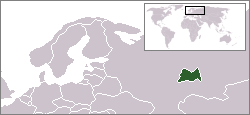
The Republic is located in the center of the East European Plain, approximately 800 kilometers (497 mi) east of Moscow. It lies between the Volga River and the Kama River (a tributary of the Volga), and extends east to the Ural mountains.
- Borders:
- internal: Kirov Oblast (N), Udmurt Republic (N/NE), Republic of Bashkortostan (E/SE), Orenburg Oblast (SE), Samara Oblast (S), Ulyanovsk Oblast (S/SW), Chuvash Republic (W), Mari El Republic (W/NW).
- Highest point: 343 m (1,125 ft)
- Maximum N->S distance: 290 km (180 mi)
- Maximum E->W distance: 460 km (290 mi)
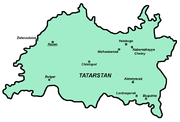
Rivers
Major rivers include (Tatar names are given in parentheses):
- Belaya River (Ağidel)
- Ik River (Iq)
- Kama River (Çulman)
- Volga River (İdel)
- Vyatka River (Noqrat)
Lakes
Major reservoirs of the republic include (Tatar names are given in parentheses):
- Kuybyshev Reservoir (Kuybışev)
- Lower Kama Reservoir (Tübän Kama)
The biggest lake is Qaban. The biggest swamp is Kulyagash.
Hills
- Bugulma-Belebey Upland
- Volga Upland
- Vyatskie Uvaly
Natural resources
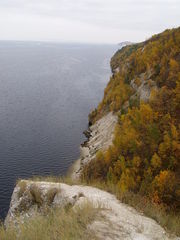
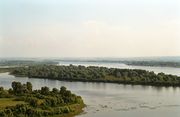
Major natural resources of Tatarstan include oil, natural gas, gypsum, and more. It is estimated that the Republic has over one billion tons of oil deposits.[16]
Climate
- Average January temperature: −16 °C (3.2 °F)
- Average July temperature: 19 °C (66.2 °F)
- Average annual precipitation: up to 500 mm (20 in)
Administrative divisions
Demographics
- Population: 3,779,265 (2002)
- Urban: 2,790,661 (73.8%)
- Rural: 988,604 (26.2%)
- Male: 1,749,050 (46.3%)
- Female: 2,030,215 (53.7%)
- Females per 1000 males: 1,161
- Average age: 36.5 years
- Urban: 35.7 years
- Rural: 38.7 years
- Male: 33.8 years
- Female: 38.8 years
- Number of households: 1,305,360 (with 3,747,267 people)
- Urban: 970,540 (with 2,762,818 people)
- Rural: 334,820 (with 984,449 people)
- Vital statistics
- Source: Russian Federal State Statistics Service
| Births | Deaths | Birth rate | Death rate | |
|---|---|---|---|---|
| 1970 | 47,817 | 25,622 | 15.2 | 8.1 |
| 1975 | 55,095 | 29,686 | 16.6 | 9.0 |
| 1980 | 54,272 | 32,758 | 15.7 | 9.5 |
| 1985 | 64,067 | 34,622 | 18.1 | 9.8 |
| 1990 | 56,277 | 36,219 | 15.4 | 9.9 |
| 1991 | 50,160 | 37,266 | 13.6 | 10.1 |
| 1992 | 44,990 | 39,148 | 12.1 | 10.6 |
| 1993 | 41,144 | 44,291 | 11.0 | 11.9 |
| 1994 | 41,811 | 48,613 | 11.2 | 13.0 |
| 1995 | 39,070 | 48,592 | 10.4 | 12.9 |
| 1996 | 38,080 | 45,731 | 10.1 | 12.1 |
| 1997 | 37,268 | 46,270 | 9.9 | 12.3 |
| 1998 | 37,182 | 45,153 | 9.8 | 11.9 |
| 1999 | 35,073 | 46,679 | 9.3 | 12.3 |
| 2000 | 35,446 | 49,723 | 9.4 | 13.1 |
| 2001 | 35,877 | 50,119 | 9.5 | 13.2 |
| 2002 | 38,178 | 51,685 | 10.1 | 13.7 |
| 2003 | 38,461 | 52,263 | 10.2 | 13.8 |
| 2004 | 38,661 | 51,322 | 10.3 | 13.6 |
| 2005 | 36,967 | 51,841 | 9.8 | 13.8 |
| 2006 | 37,303 | 49,218 | 9.9 | 13.1 |
| 2007 | 40,892 | 48,962 | 10.9 | 13.0 |
| 2008 | 44,290 | 48,952 | 11.8 | 13.0 |
Ethnic groups
There are about two million ethnic Tatars and a million and a half ethnic Russians, along with significant numbers of Chuvash, Mari, and Udmurts, many of whom are Tatar-speaking. The Ukrainian, Mordvin, and Bashkir minorities are also significant. Most Tatars are Sunni Muslims, but a small minority known as Keräşen Tatars are Orthodox and some of them regard themselves as being different from other Tatars even though most Keräşen dialects differ only slightly from the Central Dialect of the Tatar language.[17] There is a fair degree of speculation as to the early origins of the different groups of Tatars, but most Tatars no longer view religious identity as being as important as it once was, and the religious and linguistic subgroups have intermingled considerably. Nevertheless, despite many decades of assimilation and intermingling, some Keräşen demanded, and were awarded, the option of being specifically enumerated in 2002. This has provoked great controversy however, as many intellectuals have sought to portray the Tatars as homogenous and indivisible.[18] Although listed separately below, the Keräşen are still included in the grand total for the Tatars. Another unique ethnic group, living in Tatarstan only are the Qaratay Mordvins.
According to the 2002 Census the ‘national composition’ was • Ethnic Tatar (52.92%) • Ethnic Russian (39.49%) • Chuvash 3.35% • Udmurt 0.64% • Ukrainian 0.64% • Mordvin 0.63% • Mari 0.50% • Keräşen Tatars 0.50% • Bashkir 0.39% • Azeri 0.26% • Belarusians 0.16% • Armenian 0.16% • Uzbek 0.13% • Tajik 0.10% • Jewish 0.09% • Ethnic German 0.08% • Kazakh 0.05% • Georgian 0.05% • Moldovan 0.03% • Roma 0.02% • Lezgin 0.02% • and various other groups of less than eight hundred persons each. • An additional 0.02% of residents declined to state their nationality or ethnocultural identity on the census questionnaire.[19] Historical figures are shown below:
| census 1926 | census 1939 | census 1959 | census 1970 | census 1979 | census 1989 | census 2002 | |
|---|---|---|---|---|---|---|---|
| Russians | 1,118,834 (43.1%) | 1,250,667 (42.9%) | 1,252,413 (43.9%) | 1,382,738 (42.4%) | 1,516,023 (44.0%) | 1,575,361 (43.3%) | 1,492,602 (39,5 %) |
| Tatars | 1,263,383 (48.7%) | 1,421,514 (48.8%) | 1,345,195 (47.2%) | 1,536,430 (49.1%) | 1,641,603 (47.6%) | 1,765,404 (48.5%) | 2,000,116 (52.9%) |
| Chuvash | 127,330 (4.9%) | 138,935 (4.8%) | 143,552 (5.0%) | 153,496 (4.9%) | 147,088 (4.3%) | 134,221 (3.7%) | 126,532 (3.3%) |
| Others | 84,485 (3.3%) | 104,161 (3.6%) | 109,257 (3.8%) | 112,574 (3.6%) | 140,698 (4.1%) | 166,756 (4.6%) | 160,015 (4.2%) |
The official languages are Tatar and Russian. According to the 2002 Russian Federal Law (On Languages of Peoples of the Russian Federation), the official script is Cyrillic.
Politics
The head of the government in Tatarstan is the President. As of 2008, the President is Mintimer Shaymiyev. Tatarstan's unicameral State Council has 100 seats: fifty are for representatives of the parties, other fifty are for deputies from the republic's localities. The Chairman of the State Council is Farit Mukhametshin from May 27, 1998.
According to the Tatarstan Constitution, the President can be elected only by the people of Tatarstan, but due to Russian federal law this law was suspended for an indefinite term. The Russian law about election of governors says they should be elected by local parliaments and that the candidate can be presented only by the president.
On March 25, 2005 Shaymiyev was re-elected for his fourth term by the State Council. This election was held after changes in electoral law and does not contradict the Constitutions of Tatarstan and Russia.
Political status
The Republic of Tatarstan is a constituent republic of the Russian Federation. Most of the Russian federal subjects are tied with the Russian federal government by the uniform Federal Treaty, but relations between the government of Tatarstan and the Russian federal government are more complex, and are precisely defined in the Constitution. The following passage from the Constitution defines the republic's status without contradicting the Constitution of the Russian Federation:
The Republic of Tatarstan is a democratic constitutional State associated with the Russian Federation by the Constitution of the Russian Federation, the Constitution of the Republic of Tatarstan and the Treaty between the Russian Federation and the Republic of Tatarstan On Delimitation of Jurisdictional Subjects and Mutual Delegation of Powers between the State Bodies of the Russian Federation and the State Bodies of the Republic of Tatarstan, and a subject of the Russian Federation. The sovereignty of the Republic of Tatarstan shall consist in full possession of the State authority (legislative, executive and judicial) beyond the competence of the Russian Federation and powers of the Russian Federation in the sphere of shared competence of the Russian Federation and the Republic of Tatarstan and shall be an inalienable qualitative status of the Republic of Tatarstan.
Economy
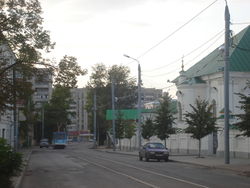
Tatarstan is one of the most economically developed regions of Russia. The republic is highly industrialized, and ranks second only to Samara Oblast in terms of industrial production per km2.[20] Tatarstan's GDP per capita was USD 12,325 in 2004[21], with GDP in 2008 at about 930 billion rubles.[16]
The region's main source of wealth is oil. Tatarstan produces 32 million tonnes of crude oil per year and has estimated oil reserves of more than 1 billion tons.[16][22] Industrial production constitutes 45% of the Republic's gross regional domestic product. The most developed manufacturing industries are petrochemical industry and machine building. The truck-maker KamAZ is the region's largest enterprise and employs about 1/5 of Tatarstan's work force.[22] Kazanorgsintez, based in Kazan, is one of Russia's largest chemical companies.[23] Tatarstan's aviation industry produces Tu-214 passenger airplanes and helicopters.[16] The Kazan Helicopter Plant is one of the largest helicopter manufacturers in the world.[24] Engineering, textiles, clothing, wood processing, and food industries are also of key significance in Tatarstan.[20]
Tatarstan consists of three distinguished industrial regions. The northwestern part is an old industrial region where engineering, chemical and light industry dominate. In the new industrial Northeast region with its core in the Naberezhnye Chelny-Nizhnekamsk agglomeration, major industries are automobile construction, chemical industry, and power engineering. The Southeast region has oil production with engineering under development. The North, Central, South, and Southwest parts of the Republic are rural regions.[25]
The Republic has a highly developed transport network. It mainly comprises highways, railway lines, four navigable rivers — Volga (İdel), Kama (Çulman), Vyatka (Noqrat) and Belaya (Ağidel), and oil pipelines and airlines. The territory of Tatarstan is crossed by the main gas pipelines carrying natural gas from Urengoy and Yamburg to the west and the major oil pipelines supplying oil to various cities in the European part of Russia.
Culture
Major libraries include the Science Library of Kazan State University and the National Library of the Republic of Tatarstan. There are two museums of republican significance, as well as 90 museums of local importance. In the past several years new museums appeared throughout the Republic.
There are twelve theatrical institutions in Tatarstan.[26] The state orchestra is the National Tatarstan Orchestra.
Education
The most important facilities of higher education include Kazan State University, Kazan State Medical University, Kazan State Technological University, Kazan State Technical University, Kazan State Finance and Economics Institute and Russian Islam University, all located in the capital Kazan.
Religion
The most common faiths are Islam, including Sunni and variants of Shi'a and Sufi belief, and the Russian Orthodox Church.
As of January 1, 2008, as many as 1398 religious organizations were registered in Tatarstan, comprising the following: 1055 - Muslim, 255 - Orthodox Christian under the Moscow Patriarchate, Real-Orthodox Church - 5, Old Believers’ Church -2, Catholics - 2, Jews - 4, Protestant communities of different doctrines – 71 (Evangelic Christians-Baptists - 4, Evangelic Christians – 30, Christians of Evangelic faith – 16, Adventists of the 7th day – 10, Lutherans – 5, New Apostle Church – 1), Jehovah’s Witnesses -5, Bahá'í Faith – 1, Krishnaists – 2, Church of the Last Testament (Vissarionov’s) – 1.
See also
|
|
Further reading
- Lost Cosmonaut: Observations of an Anti-tourist Daniel Kalder
- The Model of Tatarstan: Under President Mintimer Shaimiev Ravil Bukharaev
- The Volga Tatars: A Profile in National Resilience Azadeayse Rorlich
References
- ↑ Президент Российской Федерации. Указ №849 от 13 мая 2000 г. «О полномочном представителе Президента Российской Федерации в федеральном округе». Вступил в силу 13 мая 2000 г. Опубликован: "Собрание законодательства РФ", №20, ст. 2112, 15 мая 2000 г. (President of the Russian Federation. Decree #849 of May 13, 2000 On the Plenipotentiary Representative of the President of the Russian Federation in a Federal District. Effective as of May 13, 2000).
- ↑ Госстандарт Российской Федерации. №ОК 024-95 27 декабря 1995 г. «Общероссийский классификатор экономических регионов. 2. Экономические районы», в ред. Изменения №5/2001 ОКЭР. (Gosstandart of the Russian Federation. #OK 024-95 December 27, 1995 Russian Classification of Economic Regions. 2. Economic Regions, as amended by the Amendment #5/2001 OKER. ).
- ↑ http://www.kcn.ru/tat_en/kazan/
- ↑ According to Article 68.1 of the Constitution of Russia, Russian is the official language on the whole territory of the Russian Federation. Article 68.2 further stipulates that only the republics have the right to establish official languages other than Russian.
- ↑ Constitution, Article 8.1
- ↑ Kempton, Daniel R and Terry D. Clark, Unity or separation: center-periphery relations in the former Soviet Union, (Praeger Publishers, 2002), 110.
- ↑ 7.0 7.1 7.2 Федеральная служба государственной статистики (Federal State Statistics Service) (2004-05-21). "Численность населения России, субъектов Российской Федерации в составе федеральных округов, районов, городских поселений, сельских населённых пунктов – районных центров и сельских населённых пунктов с населением 3 тысячи и более человек (Population of Russia, its federal districts, federal subjects, districts, urban localities, rural localities—administrative centers, and rural localities with population of over 3,000)" (in Russian). Всероссийская перепись населения 2002 года (All-Russia Population Census of 2002). Federal State Statistics Service. http://perepis2002.ru/ct/html/TOM_01_04_1.htm. Retrieved 2010-03-01.
- ↑ The value of density was calculated automatically by dividing the 2002 Census population by the area specified in the infobox. Please note that this value may not be accurate as the area specified in the infobox is not necessarily reported for the same year as the Census (2002).
- ↑ Федеральная служба государственной статистики (Federal State Statistics Service) (2004-05-21). "Территория, число районов, населённых пунктов и сельских администраций по субъектам Российской Федерации (Territory, Number of Districts, Inhabited Localities, and Rural Administration by Federal Subjects of the Russian Federation)" (in Russian). Всероссийская перепись населения 2002 года (All-Russia Population Census of 2002). Federal State Statistics Service. http://perepis2002.ru/ct/html/TOM_01_03.htm. Retrieved 2008-10-17.
- ↑ 10.0 10.1 Constitution, Article 9.2
- ↑ Official website of the President of the Republic of Tatarstan. http://shaimiev.tatar.ru/eng/news/view/74419
- ↑ (Tatar) Президент Татарстанның милли идеясен - "Булдырабыз!" дип билгеләде
- ↑ Declaration on the State Sovereignty of the Tatar Soviet Socialist Republic
- ↑ 14.0 14.1 (In Russian)Конституция Республики Татарстан
- ↑ Treaty on Delimitation of Jurisdictional Subjects and Powers between Bodies of Public Authority of the Russian Federation and Bodies of Public Authority of the Republic of Tatarstan
- ↑ 16.0 16.1 16.2 16.3 Economy: The Republic of Dagestan
- ↑ Tatar The language of the largest minority in Russia. American Association of Teachers of Turkic. http://www.princeton.edu/~turkish/aatt/tatar.htm. Retrieved 2007-03-10.
- ↑ (PDF) Tatars as Meso-Nation. Hokkaido University. http://src-h.slav.hokudai.ac.jp/coe21/publish/no7_ses/chapter04.pdf. Retrieved 2007-03-10.
- ↑ (XLS) National Composition of Population for Regions of the Russian Federation. 2002 Russian All-Population Census. 2002. http://www.perepis2002.ru/ct/doc/English/4-2.xls. Retrieved 2006-07-20.
- ↑ 20.0 20.1 Tatarstan Microsoft Encarta
- ↑ Human Development Index in the Regions of Russia United Nations
- ↑ 22.0 22.1 Tatarstan Economy
- ↑ Kazanorgsintez
- ↑ Kazan Helicopter Plant (KHP)
- ↑ General information on the Tatarstan Republic
- ↑ Culture: The Republic of Tatarstan
Further reading
- 30 ноября 1992 г. «Конституция Республики Татарстан». (November 30, 1992 Constitution of the Republic of Tatarstan. ).
External links
- (English) Official website of Tatarstan
- (English) President of the Republic of Tatarstan Mintimer Shaimiev. Official web-site
- (English) Tatarstan Government
- (English) Information agency оf Tatarstan
- (English) A text of the agreement between the Government of the Russian Federation and the Government of the Republic of Tatarstan "On Delimitation of Authority in the Sphere of Foreign Economic Relations".
- Сonstitution of the Republic of Tatarstan
- Treaty Between the Russian Federation and the Republic of Tatarstan
- Declaration on the State Sovereignty of the Tatar Soviet Socialist Republic
- List of Intergovernmental Agreements Between the Russian Federation and the Republic of Tatarstan
|
||||||||||||||||
|
||||||||||||||||||||||||||||||||||
|
||||||||||||||||||||||||||